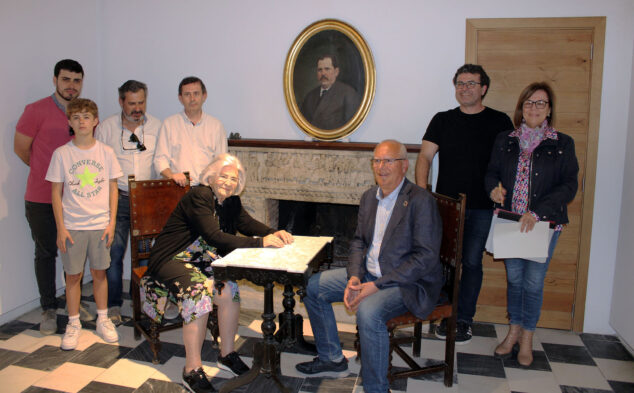Matilde París Noguera, owner of the painting, has been in charge of signing the agreement for the transfer of the portrait that the well-known Llorens painter, Domingo Llorens Cervera, made of his grandfather in the second half of the 20th century. In the act, to which Paris has attended together with two generations of relatives -children and grandchildren-, a temporary assignment for XNUMX years of the work to the Dénia City Council has been signed, with the forecast that it occupies one of the walls of the Ethnological museum Denia.
Massu Sentí, in charge of the municipal Archeology area, has highlighted the importance of a work that is "dispersed" and the biography of whose author "is not well known either, taking into account the few bibliographic evidence and that oral sources are sometimes contradictory."
For his part, the mayor of Dénia, Vicent GrimaltAnd the councilman of Culture, Raúl García de la Reina, have wanted to thank Paris for this temporary assignment, which had already taken place between March and October 1994. The work of her husband, Antonio Calabuig Adan, "who was a fervent and energetic activist for the Dianense patrimony", affirms the archaeologist. Among the actions that have stood out is the return of the Gothic Cross from the Plaza del Convento from Oriola -which is currently in the Ethnological Museum- or the attempts to make the image of Sant Roc that guards the Cathedral of Valencia or the Mare de Déu del Roser, currently located in the Provincial Archaeological Museum of Alicante (MARQ), returned to the city.
Picture
Sentí He has explained the characteristics of this work in oil on canvas with a circular wooden frame covered in plaster and gold, in the Alfonsino style, which fits with the characteristics of Noucentista painting, the period in which Llorens developed his work. In this portrait of Diego París Morales with an almost frontal perspective, the archaeologist highlights "the meticulousness and detail in the execution." She explains that the dark background is a way to bring out the portrait, done in lighter tones so the attention doesn't go anywhere else.
The painter Llorens and his time
The Dianense painter, known for his portraits of the city's bourgeoisie, lived in a Dénia marked by the end of the Old Regime, a time in which the city stood out for the cultivation and export of raisins, a time of flourishing for the merchant and landowning bourgeoisie.
His artistic career began in the studio of the Valencian artist Vicente López, who would be his mentor. He was able to learn from the chamber painter of the court of Fernando VII thanks to the intercession of his uncle, Fra Andrés Llorens, who is the protagonist of another of the portraits of the painter kept by the Ethnological Museum, thanks to the donation of the Dénia Foundation, and took care of him since he was orphaned. By his own decision, Llorens returned to settle in Dénia around 1855, the location where he would develop his most praised work.
Sentí encourages students and professionals from the world of Art History to study the painter, his work and his legacy; while highlighting "the desire to develop a monographic exhibition on the Dianense artist", such as the one held in 1958 with Arturo Vicent and Francisco Calabuig as curators and authors of the catalogue, where 52 works by the painter were exhibited.








